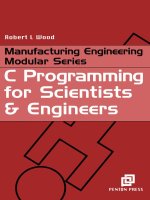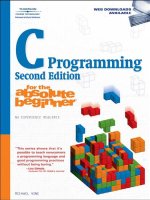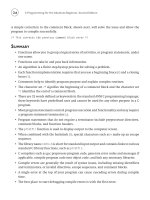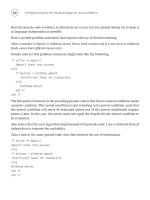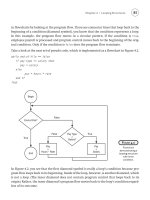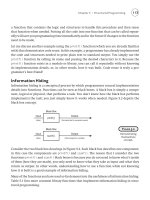C Programming for Scientists & Engineers phần 1 pptx
Bạn đang xem bản rút gọn của tài liệu. Xem và tải ngay bản đầy đủ của tài liệu tại đây (1.12 MB, 15 trang )
TEAMFLY
Team-Fly
®
C
Programming
for
Scientists
&
Engineers
This page intentionally left blank
Manufacturing Enginoxring
Modular SeriEs
C
Programming
for
Scimtists
G
Engincws
Robert
1
Wood
Publisher's
note
Every
possible
effort
has
been made
to
ensure that
the
information contained
in
this book
is
accurate
at the
time
of
going
to
press,
and the
publishers cannot
accept responsibility
for any
errors
or
omissions, however caused.
All
liability
for
loss,
disappointment, negligence
or
other damage caused
by the
reliance
of the
information
contained
in
this handbook,
of in the
event
of
bankruptcy
or
liquidation
or
cessation
of
trade
of any
company, individual;
or firm
mentioned,
is
hereby
excluded.
Apart
from
any
fair
dealing
for the
purposes
of
research
or
private study,
or
criticism
or
review,
as
permitted under
the
Copyright, Designs
and
Patents Act,
1988, this publication
may
only
be
reproduced, stored
or
transmitted,
in any
form,
or by any
means,
with
the
prior permission
in
writing
of the
publisher,
or in the
case
of
reprographic reproduction
in
accordance
with
the
terms
of
licences issued
by
the
Copyright Licensing Agency. Enquiries concerning reproduction outside
those terms should
be
sent
to the
publishers
at the
undermentioned
address.
First
published
in
2002
by
Penton
Press
an
imprint
of
Kogan Page
Ltd
120PentonvilleRoad
London
N1 9JN
www.kogan-page.co.uk
©
Robert
L
Wood, 2002
British Library
Cataloguing
in
Publication
Data
A
CIP
record
for
this book
is
available
from
the
British Library
ISBN
1
8571
8030
5
Typeset
by
Saxon Graphics Ltd, Derby
Printed
and
bound
in
Great Britain
by
Biddies Ltd, Guildford
and
King's
Lynn
www.
biddies.
co. uk
Contents
Introduction
1
1.
Variables, Data Types
and
Declaration Statements
6
1.1
Introduction
6
1.2
The
character
data
type
7
1.3
The
integer data
type
10
1.4
The
real data type
13
1.5
The
pointer data
type
15
1.6
Arrays
19
1.7
Character strings
22
1.8
Data structures
24
1.9
Pointers
to
data structures
28
Chapter
review
30
2.
Introduction
to
Executable Statements
31
2.1
Introduction
31
2.2
Arithmetic operators
32
2.3
Relational
and
logical operators
36
2.4
Identifying
operators
39
2.5
Miscellaneous operators
42
2.6
Operator precedence
45
Chapter
review
47
3.
Introduction
to
Functions
49
3.1
Introduction
49
3.2
Essential statements
in any
function
51
3.3 The
interface
between calling
and
called
functions
52
3.4
Non-empty
argument lists
and
return statements
54
vi C
programming
tor
scientists
and
engineers
3.5
Using functions
to
read
and
write data
62
3.6 A
program
to
calculate
the
area
of a
triangle
67
Chapter review
71
4.
Decisions
and
Loops
73
4.1
Introduction
73
4.2 The
if-else
construct
74
4.3
Compound statements
75
4.4
Nested
if-else
statements
76
4.5 The
switch
construct
78
4.6 The
for
loop
81
4.7 The
while
loop
86
4.8 The
do-while
loop
90
Chapter
review
91
5.
Files
and
Formatting
92
5.1
Introduction
92
5.2
Reading
and
writing
92
5.3
Formatted output
100
5.4
Line output
102
5.5
Line input
104
Chapter
review
112
6.
Dynamic Memory Management
and
Linked Lists
114
6.1
Introduction
114
6.2
Essential
facilities
for
dynamic memory
management
115
6.3
Simple applications
of
dynamic memory
management
117
6.4
Linked lists
125
Chapter review
131
Appendix:
Typical Examination
Questions
132
Background
and
Rationale
of the
Series
140
Index
142
Introduction
The aim of
this book
is to
provide
a
rapid
introduction
to the C
programming language.
C is a
procedural language
and
should
not
be
confused
with
C+ + ,
which requires
a
significantly
different
way
of
thinking about problems
and
their solutions. With
the
explosion
of
texts
on C++ and
other object-oriented languages
in
recent
years,
along with
the
perception that
C + + is
somehow
a
progression beyond
C, it may
seem
a
little strange
to
consider
a
programming book that
is not
object oriented.
I
feel
that there
are
two
good reasons
for
producing this book.
Firstly,
object-oriented
analysis,
design
and
programming techniques have evolved
to
provide
interactive
software
that
is
extremely good
at
supporting
complex
tasks performed
by its
users. However, supporting
computer users
in
this
way is
just
one
aspect
of
software devel-
opment. Another
significant
aspect
is the
support
of
numerical
analysis
and
computer-based modelling
in a
wide range
of
engi-
neering
and
other
scientific disciplines, where
the
priority
is to
solve
equations
as
quickly
as
possible. Examples
of
this
are
numerous
-
the
modelling
of
stress
and
temperature distributions
in the
design
of
aircraft
and
automobiles,
the
modelling
of fluid flow in
weather
and
climate prediction,
the
modelling
of
interactions between
molecules
and
atoms
in the
engineering
of
therapeutic drugs
and
new
materials.
Using
computers
to
perform
the
calculations
in
these
and
many
other technical applications
is a
very different problem
from
enabling
a
computer user
to do
almost anything they want
in any
sequence. Both problems
are
very
important,
but
they
need
different
tools
for
their solution. Procedural languages, such
as C,
are
typically
more appropriate than object-oriented languages, such
2 C
programming
for
scientists
and
engineers
as
C ++, for
engineering
and
scientific
calculations because
the
resulting programs
can
make more
efficient
use of the
relevant
hardware resources.
Having said that,
the
second reason
for
learning
C is
that
C++ is
C
with
added
functionality
and
that around
90% of any C+ +
program
is
actually
C. The big
difference
between
C and C + + is not
so
much
in the
languages,
but in how we
think about problems
and
their solutions. Having thought
in an
object-oriented
way,
C + + has
the
additional
functionality
over
C
that allows
us to
build
software
that
is
consistent
with
our
object-oriented thinking. Knowledge
of C
provides
around
90% of the
programming knowledge needed
to
implement object-oriented
software.
The
approach adopted throughout this book
is
biased towards
generality, rather than comprehensive detail.
To
this end, this book
does
not
cover every feature that
C
provides.
The
decision over
what
to
include
and
exclude
in an
introductory text such
as
this
can
only
be
subjective.
I
apologize
to
anyone
who
feels
that
I
have
done
programming,
and C in
particular,
a
disservice
by
excluding some-
thing that they
feel
strongly about.
My
main consideration
in
creating
and
using these notes
has
always
been
to
provide
a
firm
foundation
on
which more specialized knowledge
and
expertise
can
be
built.
The
book
is
divided into
the
following
chapters:
variables,
data types
and
declaration statements;
executable statements;
functions;
decisions
and
loops;
files
and
formatting;
dynamic
memory management
and
linked lists.
Each
chapter
is
further divided into sections
that
involve
the
reader
in
various programming activities guided
by
tutorial questions.
There
are
further tutorial problems
at the end of the
book that
aim
to
integrate each chapter topic into
the
wider
framework
of C
programming.
By
adopting this approach,
it is
intended that
the
reader
can
learn
C
through
a
series
of
small programming tasks that
become incrementally more sophisticated.
This
incremental devel-
opment
is
also used
to
instill
the
ideas
of
writing
and
using re-usable
functions
so
that,
whilst
the
tutorial questions become more sophis-
ticated, they
do not
necessarily become more complex
or
time
consuming
in
their solution.
Introduction
3
From
this,
it
should
be
clear
in the
reader's mind that this book's
main philosophy
is
that
the
only
way to
learn
a
programming
language
is to use it. If the
reader
does
not
carry
out the
programming tasks,
at
best they
will
only
gain
a
limited under-
standing
of
what
is
possible
in C. To
understand
and use C to
write
programs
that work,
it is
very
important that these
tutorial
exercises
are
carried out.
In
support
of
these exercises,
it is
worth noting that
this
book
is
independent
of any
specific
programming envi-
ronment, although
all of the
tutorial questions have been imple-
mented
in
both
the
Borland
and
Microsoft
C/C + +
environments.
A
further point concerns text
style.
All
examples
of C are
shown
in
italics, whereas
all
descriptive text looks like what
you are
reading now.
For
almost
a
decade,
the
material
in
this book
has
been
the
basis
of
both
first
and
second year undergraduate modules,
a
block-
taught
(1
week)
postgraduate module
and a
2-week
industrial
course.
It may
seem unusual that
a
single text should
be
useful
in
such
a
broad
range
of
delivery,
but
this
has
been
possible
due to the
way
in
which
the
material
has
been structured.
The
short,
but
adequately
detailed descriptions
of how
various
C
features
work,
together
with
frequent
opportunities
to
test
new
knowledge through
practical programming exercises, makes
the
material attractive
to
block
and
short course teaching beyond undergraduate level.
Under these regimes,
all
parts
of
these notes have been mandatory
and
assessment
has
involved
the
design
and
programming
of
software
to
solve
significant technical problems, such
as the
thermo-
dynamic
modelling
of a
whole engine
cycle.
In
contrast,
at the
undergraduate level, knowledge
of
Chapter
6
concerning dynamic
memory
management
is not
expected
and
there
is
less emphasis
on
the
integrating nature
of the
tutorial questions
at the end of the
book.
Also, assessment problems
are
relatively small,
but
still
of a
technically
applied nature.
Now
it is
time
to get a
little more focused
on the
subject
at
hand.
The
following
comments
are
intended
to
introduce
a
few
important
C
words
and
make clear
the
relationships between them.
All
C
programs contain statements.
The
programmer assembles
these
by
combining various operators, such
as
'add',
'divide'
etc.,
and
variables,
such
as X or Y.
There
are two
general
types
of
statements
in
C -
declaration statements that
are
used
to
create variables,
and
executable
statements used
to
combine operators
and
variables
in
ways
that make
the
computer
do
something
useful.
In all but the
4 C
programming
for
scientists
and
engineers
smallest
of
programs,
the
programmer should package
or
group
statements related
to a
particular task into
functions.
For
example,
a
program that must read
a
collection
of
input data, perform calcula-
tions
and
output
the
results could contain
a
function
for
each
of
these tasks.
Every
C
program
has a
function
called main, which
is
always
the
first
part
of the
program
to
run.
Very
small programs,
including
many
of the
examples
in
this book,
may
contain
so few
statements that they
can all
reasonably
be
contained
in
main.
In
larger programs,
main
typically
calls
or
uses other
functions
to
carry
out
particular tasks.
The C
language provides many standard
func-
tions
that perform
specific
tasks, such
as
reading
a
value
from the
keyboard,
calculating
a
square root, etc.
These
standard
functions
are
grouped into libraries and,
to use
them,
it is
necessary
to
have
a
#include
statement that refers
to the
relevant library
at the
start
of
the
program.
Where
C
does
not
provide
a
suitable
function
for the
programmer's
need,
the
programmer
must create one.
This
is
what
C
programming
is
about
-
understanding
how to
combine
C
oper-
ators
with
variables
to
form statements,
and to
group
the
statements
into appropriate
functions.
Looking back
at the
list
of
chapters,
the
first
three chapters
are
intended
to
support this
by
concentrating
on
the
terms mentioned above.
All of the
programs
in
these chapters
are
limited
to
reading data
from the
keyboard, sometimes carrying
out
a
simple sequence
of
instructions,
and
displaying results
on the
screen. Subsequent chapters build
on
this basic
functionality
by
introducing some
of the
more sophisticated
facilities
that
C
provides.
For
example, Chapter
4
takes
an
important step
forward
by
looking
at how C
programs
can
make decisions, such
as
'if ',
or
repeat sets
of
statements within
while
and for
loops. Another step
forward
is to
look
at how a C
program
can
work
with
files, in
addition
to the
keyboard
and
screen.
The final
step taken
in
this
book
is
concerned
with
how C
programs
can
create their
own
vari-
ables
in the
form
of
linked lists.
One final
comment
for
readers
who
have never programmed
before.
In C
(and
all
other
programming languages) there
are
quite
a lot of
rules that dictate
how
statements
and
functions
can
be
constructed.
For
example,
all C
statements must
end
with
a
semicolon ';'. Also, when
a
variable
is
created
it
must
be
given
a
name. Wherever
a
variable
is
used
in a
program,
its
name must
be
spelled
in
exactly
the
same
way as it is in its
declaration statement.
C
allows both upper
and
lower case symbols
to be
used
in the
TEAMFLY
Team-Fly
®
Introduction
5
names
of
variables but, again, their
use
must
be the
same wherever
the
variable
is
used.
A
good knowledge
of
these (and
a few
more)
rules
is an
important
element
of
successful
programming
and,
perhaps,
the
main
difference
between just reading
a
programming
book
and
working through
the
exercises that
it
contains.
In the
early
stages
of
learning
any
programming language,
you
need
to
recognize that
you
will
make some mistakes
and
have
to
deal with
error
and
warning messages issued
by
your programming envi-
ronment.
The
light
at the end of the
tunnel, however,
is
that
the
more attention
you pay to
detail,
the
quicker
the
error
messages
will
go
away.
Variables,
Data
Types
and
Declaration
Statements
1.1
Introduction
All programs work with data stored in memory. To make
it
easier for
us to design and understand programs, we give each data item a
unique name.
By
doing this we do not need to know where the data
item
is
stored in memory, we just use its name wherever it is needed
in the program. This is
very
similar to what
we
do when we write a
mathematical equation, for example
x
=
y
+
z,
where
x,
y
and
z
are
the names of three variables. In a
C
program,
x,
y
and
z
would also
be the names
of
three variables, each stored at a different location
or
address
in memory. The program needs to know where but,
generally, we as programmers do not. Thus, a
variable
is an item of
data that has a name and whose value can be changed within a
program. Before
a
variable
can be used, it must be given a name
and declared to be
of
some specific
data type.
This is done in a
declaration statement.
In
C
there are four basic data types:
w
Character, e.g. ‘a’,
‘b’,
‘c’,
etc.
Integer, e.g.
1,2,3,
etc.
W
Real, e.g. 1.0,2.0,3.0,etc.
Pointer.
Whilst the meaning
of
the first three types
of
data is hopefully clear
from these examples, the Pointer data type
is
rather unusual and
will be considered later.
The amount of space (the number of bytes) needed in memory
to hold a variable depends on its data type. Thus,
two
bytes may
1
Variables,
data
types
and
declaration
statements
7
be
needed
to
store
an
integer type variable
and
four
bytes
may be
needed
to
store
a
variable
of
type real.
In
addition
to
variables
of
the
basic
data
types shown above,
the
programmer
can
also define
any
group,
set or
aggregate
of
these variables.
An
array
is
used
to
hold
a
collection
of
variables where
all of the
variables
are of the
same
data type.
The
programmer
can
also create data structures,
built
up
from
various combinations
of the
basic data types, arrays
and
other data structures. Data structures have another special
significance
in C
because
C
treats them
as
programmer-defined
data types.
Sections
in
this chapter consider variables
of
each data type,
above,
showing
how
they
are
created using declaration statements
and how
they
are
used
to
store data that
is
read
from
the
keyboard
and
then displayed
on the
screen.
1.2
The
character
data
type
C
stores characters
in
memory
as
integer numbers using
the
ASCII
code.
1
Every
number
in the
ASCII code
is
small enough
to be
stored
in
a
single byte. Hence,
a
variable
of
type
character uses
one
byte.
Variables
of the
character data type
are
declared using statements
such
as:
char
A;
declares
a
variable
called
A to
hold
one
character
char
symbol,
letter;
declares variables
symbol
and
letter
to
each hold
one
character
In
a
declaration statement
char
defines
the
character data type
and
is
followed
by the
name(s)
of the
required variable(s) separated
by
commas.
Remember
from
the
Introduction that
C
requires
a
semi-
colon,
;, at the end of
each statement. Variables
of
type
char
can be
given
a
value,
or
initialized
in a
declaration statement using single
quotes,
as
follows:
char
A =
'a',
B =
'd';
charC
=
'M';
Variables
of
type
char
can
only hold
a
single character.
To
hold
a
character string, such
as a
person's name,
an
array
of
type
char
is
1
ASCII
=
American
Standard
Code
for
Information
Interchange.
8
C
programming for scientists and engineers
required. Arrays and character strings are introduced in Sections
1.6
and
1.7,
respectively.
Character data can be read from the keyboard using thefscanf
function and written to the screen using the fprintf function. For
example, Program
1.1
reads a single character from the keyboard
and displays it on the screen.
P
Program
1.1
-
Reading and wifing a character
Y
#'include
cstdi0.b
int main(void)
char
A;
fprintf(stdout, Enter
a
single character:");
fscanf(stdin,
"%c",
&A);
fprintf(stdout, "The character
is
%ch
",
A);
return(0);
1
The listing for Program
1.1
starts with a comment, giving some
indication of what the program does. The #include <stdzo.h>
statement will appear in the first group of statements in every
complete program in these notes. This statement is needed in a
program
if
it uses thefprintf orfscanffimctions. More of the detail
behind this will be revealed in Chapter
3.
Inside the program char
A;
declares a variable,
A,
which can hold a single character.
To
make
sure that the user knows that they must type a character, the
program sends a message, 'Enter
u
single character:', to the screen
using thefprintfhnction. The first
argument
(item of information),
stdout,
supplied to
fprintf
is a
stream
that connects the program to
the screen. When we use this stream, we are tellingfprintfto send the
message to the screen, rather than to some other part of the
computer, such as a file on disc. Streams are discussed hrther in
Chapter
5.
For now, however, simply remember that the stdout
stream always connects a program
to
the screen.
When the above program has displayed the message on the
screen, it then calls the fscanf function to read data from the
keyboard. Thefscunf hnction uses three arguments. The first is
a
stream, stdin, which always connects a program to the keyboard. The
second argument
is
the
control
string,
'%c'.
The
%c
part
of
the

